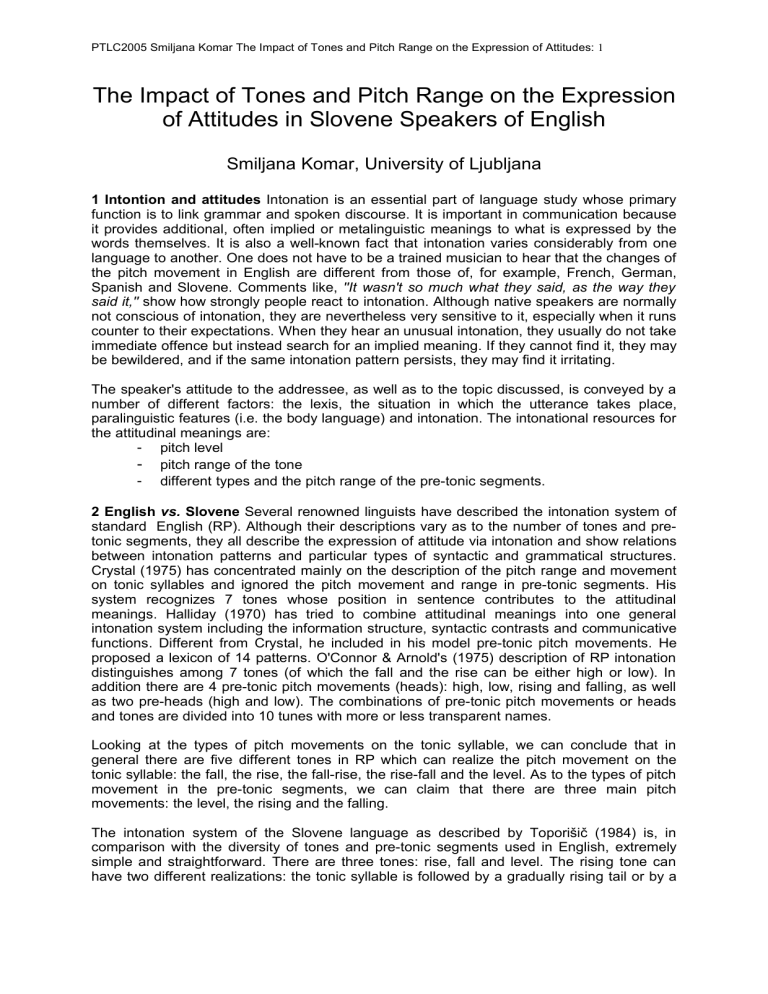The Impact of Tones and Pitch Range on the Expression

PTLC2005 Smiljana Komar The Impact of Tones and Pitch Range on the Expression of Attitudes: 1
The Impact of Tones and Pitch Range on the Expression of Attitudes in Slovene Speakers of English
Smiljana Komar, University of Ljubljana
1 Intontion and attitudes Intonation is an essential part of language study whose primary function is to link grammar and spoken discourse. It is important in communication because it provides additional, often implied or metalinguistic meanings to what is expressed by the words themselves. It is also a well-known fact that intonation varies considerably from one language to another. One does not have to be a trained musician to hear that the changes of the pitch movement in English are different from those of, for example, French, German,
Spanish and Slovene. Comments like, ''It wasn't so much what they said, as the way they said it,'' show how strongly people react to intonation. Although native speakers are normally not conscious of intonation, they are nevertheless very sensitive to it, especially when it runs counter to their expectations. When they hear an unusual intonation, they usually do not take immediate offence but instead search for an implied meaning. If they cannot find it, they may be bewildered, and if the same intonation pattern persists, they may find it irritating.
The speaker's attitude to the addressee, as well as to the topic discussed, is conveyed by a number of different factors: the lexis, the situation in which the utterance takes place, paralinguistic features (i.e. the body language) and intonation. The intonational resources for the attitudinal meanings are:
pitch level
pitch range of the tone
different types and the pitch range of the pre-tonic segments.
2 English vs.
Slovene Several renowned linguists have described the intonation system of standard English (RP). Although their descriptions vary as to the number of tones and pretonic segments, they all describe the expression of attitude via intonation and show relations between intonation patterns and particular types of syntactic and grammatical structures.
Crystal (1975) has concentrated mainly on the description of the pitch range and movement on tonic syllables and ignored the pitch movement and range in pre-tonic segments. His system recognizes 7 tones whose position in sentence contributes to the attitudinal meanings. Halliday (1970) has tried to combine attitudinal meanings into one general intonation system including the information structure, syntactic contrasts and communicative functions. Different from Crystal, he included in his model pre-tonic pitch movements. He proposed a lexicon of 14 patterns. O'Connor & Arnold's (1975) description of RP intonation distinguishes among 7 tones (of which the fall and the rise can be either high or low). In addition there are 4 pre-tonic pitch movements (heads): high, low, rising and falling, as well as two pre-heads (high and low). The combinations of pre-tonic pitch movements or heads and tones are divided into 10 tunes with more or less transparent names.
Looking at the types of pitch movements on the tonic syllable, we can conclude that in general there are five different tones in RP which can realize the pitch movement on the tonic syllable: the fall, the rise, the fall-rise, the rise-fall and the level. As to the types of pitch movement in the pre-tonic segments, we can claim that there are three main pitch movements: the level, the rising and the falling.
The intonation system of the Slovene language as described by Toporišič (1984) is, in comparison with the diversity of tones and pre-tonic segments used in English, extremely simple and straightforward. There are three tones: rise, fall and level. The rising tone can have two different realizations: the tonic syllable is followed by a gradually rising tail or by a
PTLC2005 Smiljana Komar The Impact of Tones and Pitch Range on the Expression of Attitudes: 2 very short rising tail which is then suspended and ends as a level tail. All pre-tonic segments tend to be gradually falling.
Toporišič has not tried to establish any particular attitudinal meanings his only concern being the distribution of pitch movements in different types of sentences.
From his illustrations od pitch movements, one can notice that there is hardly any step up in pitch between the last syllable of the falling pre-tonic segment and the tonic syllable carrying a fall. Instead one can expect that the falling tone will continue from the same pitch level where the falling pre-tonic segment ends.
2.1. Expected problems for Slovene speakers of English: From the comparison of the intonation systems of English and Slovene, it is expected that Slovene speakers will exhibit these features when speaking in English:
lack of the fall-rise tone
no distinction between a high and a low fall
falling pre-tonic segments
a narrower pitch range.
3. Experiment To prove the above assumptions, 11 Slovene students of English were recorded reading a dialogue. These recordings were compared with the recording of the same text read by two native speakers of English. The analysis focused on three parameters:
- the types of tones
- the pitch range of individual tones
- the pitch range of whole tunes.
4. Analysis of the model recording by native speakers The model recording consisted of
55 intonation units (IU) in which the distribution of the tones was the following:
Pre-tonic
High none
Falling none none
Falling
High
High none
High none
Tonic No.
High Fall 4
High Fall 15
Low Fall
Low Fall
Fall-Rise 8
Fall-Rise 7
1
1
Fall-Rise 5
Low Rise 6
Low Rise 1
High Rise 1
Level 5
55
Table 1. The distribution of tones in the model reading.
From the table above we can see that the prevailing tones were the high fall and the fall-rise.
There were also 6 IU where the tune consisted of a high pre-tonic segment and the low rise, which is heard as a pitch slump (i.e. a pitch movement from a relatively high to a very low pitch).
In order to find out the pitch range of individual tones, and the pitch range of the pre-tonic segments and the following tone, I measured them in semitones (ST) since a logarithmic or near-logarithmic scale better models intonational equivalence and intonational pitch range of different speakers than the physical Herzt scale.
PTLC2005 Smiljana Komar The Impact of Tones and Pitch Range on the Expression of Attitudes: 3
The measurements have shown that the average range for the high fall is 9.6 ST, whereas the step down in pitch from a high pre-tonic segment to the low rise tone is 11.6 ST on average. Furthermore, in 45 of 55 IU the English native speakers used a very wide pitch range, between ¾ and 1 full octave, i.e. 12 semitones.
5. Analysis of the recordings by Slovenes The analysis of readings by Slovene speakers has shown:
- almost the same number of intonation units (IU) as in the model reading but different tones;
- 13 IU of 55 were pronounced with the same intonation pattern;
- in 16 IU a majority of speakers decided for a different tonic syllable than the model speaker, but used the same tone;
- some speakers also decided to use the fall-rise tone.
5.1 The pitch range: There were 10 IU where Slovene speakers used the falling tone just as the model speakers. In order to find out whether there is any truth in the acoustic perception of flatness of tones, we decided to measure the pitch range of the falling tone in semitones.
IU
Susan here.
How are
Fine .
things ?
How about you ?
Only there's something I've got to sort
Hang on a minute.
I shall have to think about it.
out with him.
Eng
ST
10
16
22
13.5
10.5
5.7
Slo
ST
11.3
5.5
7.4
5.7
5
6.3
I'll tell him.
Thanks
See
, Jane.
you then.
AVERAGE
7.5
11
8
12
11.6
3.5
5.1
4.3
6.7
6.1
Table 2. Average pitch range of the falling tone in English and Slovene.
The pitch range of the falling tone is not the only factor which contributes to the acoustic perception of flatness. Particularly flat are those IU where the falling tonic syllable is to be found at the end of the unit, while the pre-tonic segment is relatively long and falling. There were two intonation units in the model reading with a falling pre-nuclear segment and the high fall. It was found out that the English speaker had descended in pitch on the pre-tonic segment by 8 semitones, and had jumped up by 12 semitones for the beginning of the falling tone. The Slovene speakers on average descended by 4.2 semitones in the pre-tonic segment and stepped up in pitch by 1.3 semitones for the beginning of the falling tone.
6. Suggestions for teachers Changing pronunciation features in foreign speakers can sometimes be very difficult. Changing well-established intonation patterns is even more difficult bearing in mind the fact that even native speakers are not conscious of them.
This is the reason why more and more teachers claim nowadays that teaching intonation is useless since intonation can hardly ever be faulty. This, however, is wrong. Some prosodic features, if used wrongly, can alter the meaning of the utterance. This particularly applies to tonicity and tonality.
The other approach to the teaching of intonation is to equip learners with a set of very general rules explaining which pitch movements are used in which types of grammatical and syntactic structures (e.g. rising intonation in questions). Such simplifications are often faulty and apply only to a small set of utterances said in a particular context of interaction.
PTLC2005 Smiljana Komar The Impact of Tones and Pitch Range on the Expression of Attitudes: 4
Teaching how intonation varies according to the speaker's attitude to the spoken interaction remains to be very difficult and for many teachers too problematic. But it need not be if the teachers are aware of the main differences between the intonation patterns and the expression of attitudes in their learners' mother tongue, as well as of the fact what misinterpretations are possible if the mother tongue intonation patterns are used in the foreign language. Thus a Slovene teacher of English should be aware of the fact that native speakers of English frequently claim that Slovene speakers sound flat in English, and consequently interpret the speakers to be dull, uninterested in conversation and even rude.
The analysis of recordings by 11 Slovenes reading in English tried to find justification for this common observation. There are two main reasons for Slovenes sounding flat in English.
First, the Slovenes produce the falling tones in a much narrower pitch range than the
English, and second, the step up in pitch from the end of the falling pre-tonic segment and the beginning of the falling tone is significantly smaller compared to the step-up in pitch made by the English speakers.
There are, however, grammatical and syntactic structures in which flat and falling intonation may be more problematic that in others. Such are farewells and greetings, exclamations and question tags. The teacher's task here would be to use real-life recordings and to demonstrate to the learners how different intonation patterns influence the behaviour of the participants in the interaction.
Last but not least, teachers should never ignore the phenomenon of fear and uneasiness when speaking in a foreign language which are often manifested in a narrow pitch range.
7. References
Crystal, D. (1975) The English Tone of Voice . London:Edward Arnold.
Halliday, M.A.K. (1970) A Course in Spoken English: Intonation.
London: Oxford University press.
O'Connor, J.D. & Arnold, G.F. (2nd edn 1973) Intonation of Colloquial English.
London:
Longman.
Toporišič, Jože (1984) Slovenska slovnica.
Maribor: Zalžba Obzorja.



